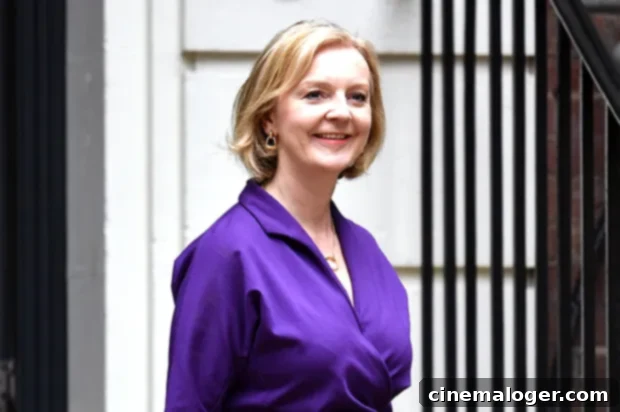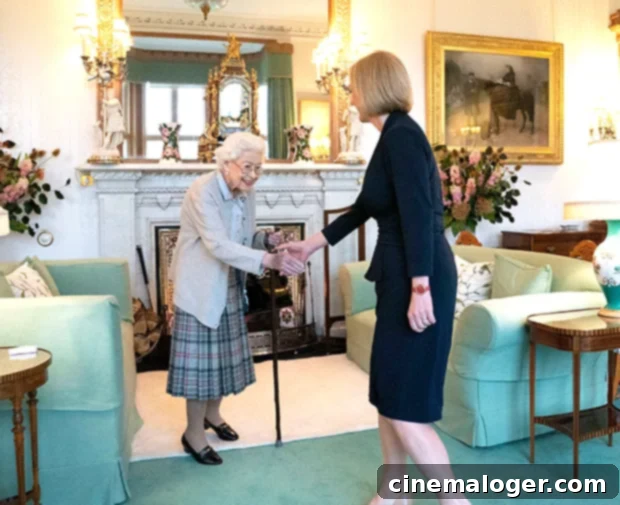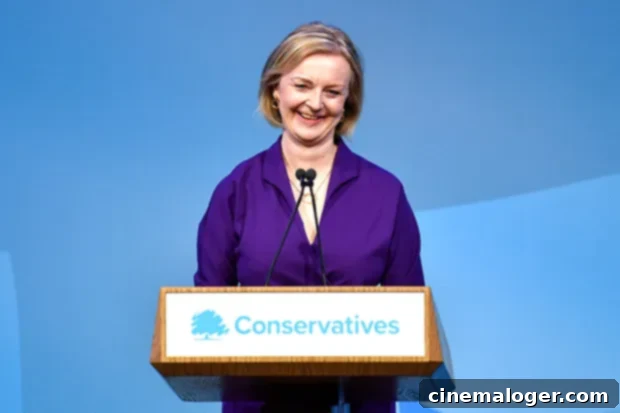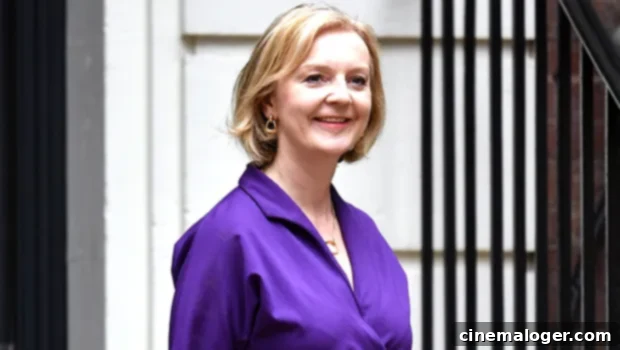Liz Truss’s Tumultuous Premiership: Unpacking Her Swift Rise and Historic Resignation as UK Prime Minister
The landscape of British politics was dramatically reshaped in the autumn of 2022 with the unprecedented resignation of Liz Truss, who served as Prime Minister for a mere 45 days. Her tenure, the shortest in the nation’s history, marked a period of intense economic and political turbulence, culminating in her admission that she could not deliver on the mandate she had campaigned on. This article delves into the political journey of Liz Truss, from her early days in Parliament to her brief but impactful time at the helm of the United Kingdom, exploring the factors that led to her historic departure.
On Thursday, October 20, 2022, Liz Truss made a statement from Downing Street announcing her decision to step down as the leader of the Conservative Party, triggering a leadership contest to find her successor. Her resignation came after a period of significant market volatility and a rapid loss of confidence from her own party, largely triggered by her government’s controversial “mini-budget.” The economic plan, which included unfunded tax cuts, sent shockwaves through financial markets, leading to a sharp devaluation of the pound and an increase in government borrowing costs. Truss acknowledged the severity of the situation, stating, “Given the situation, I cannot deliver the mandate on which I was elected by the Conservative Party. I, therefore, have spoken to His Majesty, The King, to notify him that I am resigning as leader of the Conservative Party.” Her departure underscored the immense pressures facing modern political leaders in a rapidly changing global environment.
Truss’s brief premiership began on Tuesday, September 6, 2022, following her victory in the Conservative Party leadership election. This contest was initiated after her predecessor, Boris Johnson, announced his resignation in July amidst a series of scandals. Truss, then 47, travelled to Balmoral Castle in Scotland to meet with Queen Elizabeth II, who formally invited her to form a new government. This meeting, poignant as it was one of the Queen’s last official acts before her passing just two days later, marked a historic moment as Truss became the third female Prime Minister of the United Kingdom. Her ascent to the highest office in the land was the culmination of a political career spanning over a decade, characterized by a rapid rise through various ministerial roles. While her time as PM was unexpectedly short, understanding her background offers crucial context to her political ambitions and policy decisions.

1. Liz Truss: The Third Woman to Lead the UK
Liz Truss’s election as Prime Minister was a significant milestone, making her the third woman to hold the UK’s highest political office. This achievement places her in an elite group alongside two other formidable female leaders from the Conservative Party: Margaret Thatcher and Theresa May. Upon her victory in the Conservative leadership election, Truss expressed her gratitude and commitment, tweeting, “I will take bold action to get all of us through these tough times, grow our economy, and unleash the United Kingdom’s potential.” Her ambition to enact transformative change was clear from the outset.
The legacy of female leadership in the UK began with Margaret Thatcher, often referred to as the “Iron Lady,” who served as Prime Minister from 1979 to 1990. Her eleven-year tenure was marked by radical economic reforms, privatization, and a strong stance against trade unions, fundamentally reshaping British society and the economy. Thatcher’s policies, known as “Thatcherism,” continue to be debated and analyzed for their long-term impact. The second woman to lead the country was Theresa May, who took office in 2016 following David Cameron’s resignation in the wake of the Brexit referendum. May’s premiership, lasting from 2016 to 2019, was largely defined by the complexities and divisions surrounding Brexit, as she tirelessly sought to negotiate and pass a withdrawal agreement. Despite her efforts, she ultimately resigned after failing to secure parliamentary approval for her deal. While Truss’s time in office was far shorter than her predecessors, her ambition to pursue a distinct economic philosophy, reminiscent of Thatcherite principles, was evident, aiming for rapid growth through deregulation and tax cuts. Her inability to implement this vision effectively led to her downfall, highlighting the unique challenges and political climate she faced.
2. A Decade in Parliament: From Liberal Democrat to Conservative Standard-Bearer
Liz Truss’s political journey began long before she entered Parliament, with her early career reflecting an evolving political philosophy. After studying Philosophy, Politics, and Economics at Merton College, Oxford, Truss became involved in student politics, serving as president of the Oxford University Liberal Democrats. Interestingly, during her time as a Liberal Democrat, she advocated for the abolition of the monarchy and the legalization of cannabis, positions far removed from the Conservative Party’s traditional stance. This early ideological flexibility highlights a pragmatic and evolving political mind. She made her first runs for office in the early 2000s before successfully being elected to the House of Commons in 2010, representing the constituency of South West Norfolk.
Upon joining the Conservative Party, Truss quickly established herself as a rising star. Her political views matured, aligning more closely with the party’s right-wing, particularly its libertarian approach to economic policy. This economic liberalism, advocating for free markets, lower taxes, and reduced state intervention, became a defining feature of her political identity, eventually leading to her “Trussonomics” agenda. Perhaps one of the most notable shifts in her political stance concerned Brexit. Despite initially campaigning for the UK to remain in the European Union during the 2016 referendum, Truss later became a vocal and staunch supporter of Brexit, embracing the opportunities she believed it presented for the UK to forge its own path. This transformation demonstrated her ability to adapt to the changing political landscape and position herself within the dominant currents of the Conservative Party. Her decade in Parliament was a period of continuous learning, strategic positioning, and ideological refinement, preparing her for the demanding roles that lay ahead.
3. Rapid Ascent Through Ministerial Ranks: A Diverse Cabinet Career

Liz Truss’s journey through government departments was marked by a rapid and continuous ascent, showcasing her versatility and ambition. After being elected as a Member of Parliament in 2010, she quickly moved into ministerial roles, accumulating a diverse range of experience across various portfolios. Her first appointment came in 2012 when she was made Parliamentary Under-Secretary of State at the Department of Education, a role that involved overseeing childcare and early education policy. This initial position provided her with foundational experience in government operations.
From 2014 to 2016, she served as Secretary of State for Environment, Food, and Rural Affairs. In this capacity, she dealt with critical issues such as food security, environmental protection, and agricultural policy, gaining experience in a sector vital to the UK’s economy and landscape. Following this, she took on the demanding role of Secretary of State for Justice and Lord Chancellor from 2016 to 2017. This was a significant appointment, as she was the first female Lord Chancellor in the office’s nearly 1,000-year history, underscoring her pioneering spirit. Her tenure involved navigating complex legal and judicial reforms.
Her economic leanings became more prominent during her time as Chief Secretary to the Treasury from 2017 to 2019. This role, effectively the second-in-command at the Treasury, saw her working closely on public spending and budgetary matters, providing her with invaluable insight into the nation’s finances—experience that would later influence her own economic strategy. Post-Brexit, she embraced the opportunity to shape the UK’s new global trading relationships, serving as Secretary of State for International Trade and President of the Board of Trade from 2019 to 2021. In this role, she championed free trade deals around the world, actively promoting British exports and attracting foreign investment. Her final cabinet position before becoming Prime Minister was as Secretary of State for Foreign, Commonwealth and Development Affairs under Boris Johnson, a role she held from 2021 to 2022. Concurrently, she also served as Minister for Women and Equalities. As Foreign Secretary, she played a crucial role on the international stage, responding to global crises, strengthening diplomatic ties, and advocating for British interests, further solidifying her profile as a senior government figure and a credible contender for leadership.
4. Family Life and Resilience: Liz Truss Beyond Politics
Behind the demanding public persona of a politician, Liz Truss maintains a private family life with her husband and two daughters. She met Hugh O’Leary in 1997, and the couple married in 2000. While Truss has consistently been in the public eye throughout her political career, O’Leary, an accountant, has largely maintained a private profile, offering a stable counterbalance to the often tumultuous world of politics. Although he made attempts to run for office in the late 1990s and early 2000s, his primary focus has remained outside the political spotlight. Together, they have two daughters, Frances, aged 16, and Liberty, aged 13, whose lives are, by necessity, somewhat shielded from the intense media scrutiny that accompanies a Prime Minister’s family.
Like many public figures, Truss’s personal life has faced scrutiny. The couple’s marriage endured a period of difficulty when details of Truss’s affair with fellow Conservative MP Mark Field from 2004 to 2005 became public. This challenging time tested their relationship, but Truss and O’Leary demonstrably worked through it, emerging stronger. Addressing the affair publicly, Truss stated, “I am really sorry about that [affair]. It’s a mistake I made and as far as me and my husband are concerned it’s water under the bridge.” Her candor and the couple’s ability to move past this private ordeal speak to a degree of resilience and mutual commitment. This aspect of her life highlights the human dimension of a high-profile politician, showcasing that even those in the most powerful positions navigate personal challenges while managing immense professional pressures.

5. Early Career: From Energy Sector to Think Tank Analyst
Before her foray into electoral politics, Liz Truss built a varied professional background in both the private sector and the policy world, experiences that undoubtedly shaped her economic and political perspectives. After graduating from Oxford University, she embarked on a career in the energy industry, working for Shell Oil company. This role provided her with firsthand experience in one of the world’s largest and most influential industries, exposing her to complex corporate structures, international markets, and the practicalities of large-scale operations. Following her time at Shell, she pursued accountancy, qualifying as a management accountant in 1999.
In 2000, Truss transitioned to Cable & Wireless, a telecommunications company, where her talents quickly led her to become Economic Director. In this strategic position, she was responsible for analyzing market trends, developing economic strategies, and contributing to the company’s overall financial health and growth. This role further honed her analytical skills and deepened her understanding of corporate economics and policy implications, which would prove invaluable in her later political career, particularly within roles at the Treasury and in setting national economic policy. Prior to her election to Parliament in 2010, Truss served as the deputy director of Reform, a prominent conservative think tank. Reform is known for advocating for public service reform, reduced government spending, and free-market policies. Her time at Reform allowed her to delve deeply into policy development, engaging with cutting-edge ideas on economic liberalization and efficiency in public services. This period at a think tank was crucial in solidifying her libertarian leanings and connecting her with a network of like-minded individuals who believed in radical approaches to economic challenges. These diverse experiences, from the corporate world to a leading policy institute, provided Truss with a robust foundation, equipping her with both practical business acumen and a strong ideological framework before she entered the demanding arena of parliamentary politics.
Conclusion: A Brief but Unforgettable Chapter in British History
Liz Truss’s premiership, though historically brief, remains a pivotal and often debated chapter in modern British political history. Her rapid rise to the top of the Conservative Party, fueled by a commitment to a distinctive brand of supply-side economics and a promise of decisive action, culminated in a dramatic fall from grace. The economic turmoil triggered by her government’s mini-budget, coupled with a swift loss of political authority, served as a stark reminder of the intricate balance between bold policy ambition and economic reality. Her resignation after just 45 days not only made her the shortest-serving Prime Minister but also highlighted the intense pressures facing leaders in an era of complex global challenges.
Truss’s journey from a former Liberal Democrat to a leading figure in the Conservative Party, and her steady ascent through numerous cabinet positions, showcased her resilience and political adaptability. Her commitment to lower taxes and deregulation, rooted in her libertarian economic philosophy and experience in various government roles, ultimately defined her leadership. While her time in Downing Street was cut short, the events of her premiership left an indelible mark on the Conservative Party, precipitating further leadership contests and contributing to a period of unprecedented political instability. Her legacy, though brief, will long be discussed as an example of how quickly political fortunes can turn, and the profound impact of economic policy decisions on a nation’s stability and public trust.
